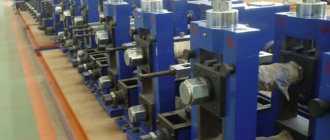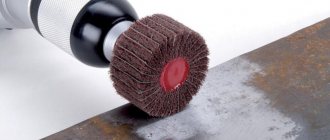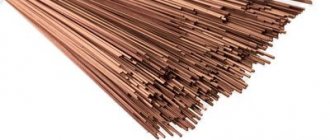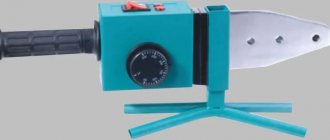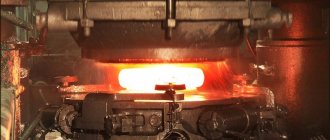Pipe rolling is a necessary part of the process of partially changing the shape of pipes, due to which hollow metal products are given the required configuration or the diameter is expanded. Pipes can be rolled in different directions, depending on the intended result. The process of changing the diameter is carried out on machines in the workshop or at home - using simple devices. Using the rolling method, it is also possible to form products from sheet metal.
To change the original shape of the pipe, a rolling operation is used
Features of the rolling process
Rolling is an affordable process for manufacturing all kinds of metal parts or pipe sections of the required format. Each tube flaring tool has its own specifics, but this process is also used for other purposes - processing a metal rod or thin sheet metal.
The name of the process comes from a primitive device - special rollers are quite simple in design and operation, but they provide a wide rounding radius for the workpieces. Industrial production involves the use of forging rollers (rolls) through which a piece of metal passes.
Correct use of the tool guarantees high-quality and uniform deformation along a given circle or at a certain angle. For example, you can get a blank of the correct cylindrical shape or a curl for a forged gate using rollers for a profile pipe with your own hands.
Rollers are selected according to the thickness of the metal product; rollers with a large radius are often required. Not only steel becomes ductile when processed with the above devices. Plastics, polymeric materials and some rods, sheets and metals are deformed in a similar way:
- aluminum;
- black metal;
- soft alloys;
- galvanization.
Rolling is also called rolling a pipe on a special machine in order to obtain a bent workpiece
Attention! Today, pipe bending and rolling is a common service, but you can master this process yourself if you have an easy-to-use device. Such skills are applicable in various folk fields and industrial production, in the manufacture of welded structures - stairs, gates, furniture.
The most common methods of forming metal products after rolling a profile pipe:
- stretching;
- bending;
- winding;
- flaring of holes.
The process involves securing the pipe into the lumen using expansion, and the diameter of the pipe must be smaller than the opening. To ensure reliable connection, rolling equipment is used. But this concept implies different processes:
- Rolling as a method of changing the width of the inlet hole, lumen or diameter of the pipe during heat treatment and welding.
- Rolling of pipe bends.
- Rolling as a method of reducing diameter.
- Rolling a section of seamless pipeline.
- Flaring the workpiece to change the diameter of the pipe (increase).
Attention! Without experience, pipe rolling is not an easy task, and with excessive force, the metal will lose its ductility and may crack, and other signs of destruction will appear.
This is interesting: Chrome plating - decorative coating of metal with chromium: technology, types
Recommendations for the use of flaring for copper tubes
High-quality flaring allows you to create a reliable and tight connection. This can only be done if you have experience. Therefore, it is recommended to practice on sections of rolled pipes of different diameters before the main installation work.
To perform high-quality flaring, also adhere to other expert advice:
- You only need to flare a pipe whose end is free of burrs, debris and various defects, including bends. The edge of the product should have a round shape.
- The expansion tip of the tool must be positioned without distortion relative to the axis of the pipe.
- When expanding a part using a homemade method, the cone-shaped blank should not be pressed, but screwed into the hole of the rolled product.
- When using a device with a matrix, it is necessary to select a hole in the bar with a size corresponding to the diameter of the workpiece.
The outer surface of the pipe near the end should always be cleaned with an abrasive sponge, regardless of the tool used. This will remove debris and dust from the product. Therefore, it will be easier to securely fix the pipe part in the holder.
Cost of services
| Sheet thickness | D=500 rub. VAT included | D=1000 rub. VAT included | D=1500 rub. with ND | D=2000 rub. VAT included | D=2500 rub. VAT included | D=3000 rub. VAT included |
| 4 mm | 3 325,00 | 5 500,00 | 8 200,00 | 10 450,00 | 13 437,50 | 15 850,00 |
| 5 mm | 3 914,00 | 6 640,00 | 10 024,00 | 13 844,00 | 15 274,00 | 20 612,00 |
| 6 mm | 3 903,00 | 8 780,00 | 12 816,00 | 15 238,00 | 19 110,50 | 24 308,00 |
| 8 mm | 6 650,00 | 11 000,00 | 16 432,00 | 30 900,00 | 25 844,50 | 33 766,00 |
| 10 mm | 6 828,00 | 12 280,00 | 20 048,00 | 25 688,00 | 30 548,00 | 39 224,00 |
| 12 mm | 8 006,00 | 13 560,00 | 21 664,00 | 28 476,00 | 34 251,50 | 44 682,00 |
| 14 mm | 9 153,00 | 15 780,00 | 25 280,00 | 33 138,00 | 39 955,00 | 52 140,00 |
| 16 mm | 10 331,00 | 18 060,00 | 28 896,00 | 37 926,00 | 45 658,50 | 59 598,00 |
| 20 mm | 13 656,00 | 22 560,00 | 36 160,00 | 47 376,00 | 57 096,00 | 74 580,00 |
| 25 mm | 15 601,00 | 28 260,00 | 45 184,00 | 59 346,00 | 71 370,00 | 93 192,00 |
| 30 mm | 18 515,00 | 33 900,00 | 54 208,00 | 71 190,00 | 85 644,00 | 111 804,00 |
| 35 mm | 25 343,00 | 45 120,00 | 72 288,00 | 94 752,00 | 114 192,00 | 149 094,00 |
Pipe rolling tool.
Rice . 3 . Lid rolling (self-feeding):
1 - spindle (rod); 2 - cover; 3— rollers.
Self-feeding rollers are sometimes incorrectly called impact rollers. Self-feeding rollers have some skew of the windows for the rollers (skew in relation to the body).
A hand-rolled cone is rotated by a regular crank placed on the square of the cone head.
The main features of various types of rolling bodies are the presence of a thrust plane or a special thrust ring, as well as the method of making windows for the rollers and their bracing.
The purpose of the thrust plane is to make it possible to correctly install the rolling (screw rolling) or to limit the translational movement of the rolling body during the rolling process (self-feeding rolling).
Rolling bodies are made with a cover (Fig. 3.) which is a stop with a movable installation thrust ring.
If we compare some designs of rolling machines, it can be noted that the thrust plane will work correctly only if it receives the necessary stop in the tube sheet. It is important to note that all protruding ends of the rolled pipe must be cut to the same height.
Pipe rolling video.
Currently, automatic rolling using a machine is used. This method significantly reduces rolling time and labor intensity, and as a result, productivity increases. Rolling using a machine drive has the following advantages:
a) the rate of pipe expansion per revolution of the rolling body is not limited by any limits;
b) the end of the flaring is determined automatically by the flaring limiter, based on the magnitude of the force on the flaring cone;
c) the rolling process proceeds evenly and smoothly.
You can see an example of such rolling in the video below.
Pipe flaring kit
The choice of tools for making more copper products is very wide. It may include the following combinations: • Mechanical flaring machine.
• Electric flaring machine.
• Set for rolling copper tubes, which also has expanders, pipe cutters and wrenches for work.
It is better to buy such a set when you are going to constantly perform such installation work, for example, for your own income. And if you only need to perform expansion once, then the simplest set for universal work, which contains a regular flaring machine, is also suitable.
Flaring stages
To obtain a reliable connection for a pipeline made of copper tubes, it is necessary to correctly roll the structure. And if you decide to flare the pipes yourself, then you need to follow these steps to do everything correctly: 1. First you need to clean the end of the pipe. 2. Then you put a specially selected coupling on the stripped part. 3. The pipe must be inserted into the flaring machine, then rotate it until a small edge of forty-five degrees is obtained. 4. Then carefully remove the completed product. 5. And use a coupling to secure two sections of the ends of the pipe. Of course, not only such fittings can be connecting parts. With the help of a professional flaring machine, you can prepare pipes for soldering fastening. The methods are basically similar. They involve deliberate deformation of the pipe to a certain size.
Flaring tool set
When doing it at home yourself, you first need to prepare the main tool:
- pipe cutter;
- chamfering rimmer;
- one of the available flaring machines.
Tube flaring kit.
The flaring process must be carried out in stages. If you follow all the nuances and recommendations of specialists, it will be possible to create neat sockets with the correct geometry at the ends of the pipes. Therefore, the connections will be tight and reliable.
Specific terminology of different rolling methods
The concept of “pipe rolling” is a bit of a misnomer from a linguistic point of view. This term implies two opposite operations, and parts of the deformation of the workpieces are performed without rollers.
Summarizing the terminology, it is worth mentioning that rolling is:
- changing the shape of the pipe (turning into a round, square, oval shape);
- bending at an angle or along a radius;
- molding a round or flat blank into a tube-shaped product;
- end expansion or enlargement of one end of the pipe in order to prepare for joining with a part or fragment of the pipeline;
- crimping the end of the pipe end to create a hermetically sealed joint (reducing the diameter);
- cutting metal to give the end of the pipe a different shape and diameter.
Privaltsovka. The expansion process begins after the pipe is inserted into the forming hole. This eliminates the gap between the edges of the hole and the pipe bender. Next, you need to apply force to start the deformation process with a tighter joint.
Hand tools are used to flare soft metal pipes
Flaring of steel pipes is the most common method of deforming pipelines and other products. This is a method of expanding the diameter of one of the pipeline fragments - for high-quality articulation of the sections. After such processing, the communication sections are joined using a telescopic method - the end of one pipe fits as tightly as possible into the next fragment.
Flaring of copper pipes is often used when installing water pipes and air conditioning systems. This operation (as for all other metal pipes) is performed with the following equipment:
- clamp (expander);
- ratchet (adjusts pressing force);
- cone or funnel (changes the diameter to a larger value).
Attention! Cone-shaped equipment is used for malleable and ductile metals.
Rolling is the reverse process of flaring, reducing the inlet opening of the pipeline. Often, simple devices such as a vice and a hammer are used to narrow the diameter. Also, the edges can be given a different shape - like profiled pipes. This method also eliminates defects on the edges of the tubes that occurred during cutting.
This is interesting: Shewing - processing of gears: equipment, nuances of the process
Existing types of rolling
In the modern world, there are a number of special operations that are united under a common non-specialized name - rolling. The processes included in this series may differ significantly from each other both in the method of execution and in the features of the equipment used. The most commonly used ones will be discussed below, namely radial deformation and pipe bending.
Radial deformation
It is carried out by increasing or decreasing the cross-section in diameter. Increasing the diameter is called flaring, the reverse process (decreasing) is called rolling.
These processes are carried out as follows:
- Flaring - the cross-section in diameter expands by increasing the diameter, due to which a small socket is formed at the end of the pipe. This socket will be the key to performing a fitting-free connection of various pipeline elements. After the necessary expansion has been created, it is possible to insert a pipe of a smaller diameter into the resulting socket. And then securely fix the connection.
- Rolling - in this process, the diameter of the pipe is subject to reduction (as opposed to the process described above), in which the cross-section smoothly narrows with the help of applied forces. This is done to ensure that the end of the rolled pipe fits properly into the socket of the wider one and is securely fixed.
IMPORTANT! Both of the above processes are performed only on non-brittle metals without preheating. When work is carried out with hard metals, which are prone to cracking under mechanical loads, then preheating is more likely to be needed than not. The heated part will become much more pliable and elastic.
Pipe bend
This type of rolling is used in the manufacture of various pipe connections and consists of simply bending the pipe in a certain place. To perform this operation you will need the following tools:
- External and internal springs - they are used to change the shape of metal-plastic pipes. The essence of the process is to decompress one spring and put pressure on the other, thereby forming a bend. This method is only good for soft metals (for example, copper, aluminum) and is not suitable for working with hard ones.
- A pipe bender itself is the optimal solution for bending pipes to the required angle. With its help, in addition to bending, it is possible to maintain the required pipe turning radius. The principle of operation is to apply muscle force to the turning lever.
- Bending rollers are special devices that allow you to work with products made of hard materials. The rollers are installed on a special platform, which is equipped with special rollers located at a certain distance from each other. The tubular product is rolled through these rollers. And thanks to the adjustment of the pressure roller, it will be possible to set both the radius and the bend angle.
Why and where is it used?
The core industry that uses the rolling process can safely be called the metalworking industry. Next on the list are all areas in which pipes and pipe connections are used. Rolling is used both to create air conditioner tubes, corrugated stainless steel pipes or heat exchanger tubes, and for very complex structures (such as a steam boiler drum).
With the help of rolling, it is possible to adjust pipelines in place for non-standard solutions. Thus, it is possible to avoid difficulties in creating new highly specialized products.
Rolling is used not only in industry, but also in everyday life. This procedure is relevant in the following cases:
- connection of air conditioner units during installation;
- laying gas and plumbing pipes;
- when soldering copper tubes of refrigeration units;
- Replacement of car brake system pipes.
Flaring tools
Using the following tools, it is possible to increase the cross-sectional diameter of the pipe (gradation is given from a simple device to a more complex one):
- An iron cone with a smooth surface is a favorite device of most professional plumbers and split system installers. It is a cylinder ground to a cone shape with a subsequently polished surface. The principle of its operation is very simple. The top of the cone is inserted into the desired section of the pipe and rotated several times. The device itself, due to the simplicity of its design, has a long service life. However, it is possible to work with it only on soft materials.
- A cone with a ratchet is a more technologically advanced and complex device. The principle of its operation is largely similar to that described above, however, when the cone enters the socket, the existing ratchet simplifies the screwing process and helps regulate the applied forces.
- The expander is designed to carry out the flaring process quickly and efficiently. Its working part consists of several segments. The working part is inserted into the socket, after which the operator, squeezing the handles of the expander, expands the existing socket to the required size, stretching the pipe. At the same time, the working segments diverge from each other. The disadvantage of using this device is that after operation the edges of the bell are not even.
- The eccentric cone flaring tool is the most modern solution among popular devices for flaring soft materials. To use, you just need to insert the cone, then turn the handle until the bell changes to the desired diameter. Such tools are good because they are equipped with a fuse that prevents the bell from breaking.
Features of rolling at home
In everyday life, rolling of products made of copper, aluminum, galvanized and stainless steel is performed on universal bending rollers that can replace machines, pipe benders and special equipment. The quality of work depends on the thickness of the walls and the suitability of the equipment for the task.
A high-quality rolling tool is quite reliable, does not require repairs, and has been used for many years. For work in home mini-shops, compact machines of the RT, R, T, SR, 5R and ST groups (mentioned above) are used. Rolling a profile pipe is more difficult to do than transforming a rounded workpiece.
Advice! Many products are easier to bend at home after heating with a blowtorch - for greater plasticity.
When rolling copper or aluminum pipes with your own hands, it is important not to rush and monitor the deformation process. With excessive pressure, the hole may expand more than required, and it is very problematic to “seal” it back. Breaks are most likely on copper and steel pipes, so all stages must be done according to technology.
Do-it-yourself flaring - recommendations
In any case, no matter what method and method of flaring is chosen, the main task will be to obtain a smooth surface (almost mirror-like) of the bell, and it should be free of distortions and tears, grooves and dents, and the walls should be the same thickness everywhere. The tightness of the connection will depend on all these points in the future. It is better to carry out the process itself not with improvised means, but with the help of a special tool - in this case, the likelihood of obtaining a high-quality result will increase significantly. In addition, you should decide in advance on the thickness limit of future walls and not try to exceed the established limit. At the same time, too thin walls (especially on soft metals) can subsequently lead to the independent formation of cracks, which will lead to depressurization of the system as a whole.
Profile products
Profile products are manufactured in the following sequence:
- Strips are flat-shaped steel blanks, cut into narrow strips.
- The strips are butt welded to form an endless strip, which is wound on top of the drum.
- When the tape is needed, it is run onto the machine and rolled into round blanks.
- The edge is cooked, in most cases using induction current.
- The rolling machine gives the desired shape. Mechanical rollers can make any shape, even the profile of a person if desired.
Rolling of round pipes is also possible. Such processes are cheap and easy to perform.
Advice: if the product has undergone cold deformation, after finishing the work it should be thoroughly heated and allowed to cool on its own. This way you will relieve the tension that has arisen in the middle of the product.
If you use a homemade profile pipe when building a water supply system, then it is better not to overdo it when heating. Take an ordinary soldering lamp or transformer welding.
Technology
Like any other technological operation, rolling has its own GOSTs and OSTs that regulate and regulate the process and its parameters, for example: tightness control, calibration, tolerances on pipe wall thickness. Enterprises also have their own service stations for these purposes. Let us present a short list of these documents.
- GOST 13954-74 (reissued in January 1988 with Amendments No. 1, 2). Pipe ends flared for connecting pipelines along an outer cone. Design and dimensions.
- GOST R 55601-2013. Heat exchangers and air cooling units. Fastening pipes in tube sheets.
- GOST 28941.12-91 . Pipeline connections with pipe flaring. The ends of the pipes are flared.
- OST 26-02-1015-85. Industry standard. Fastening pipes in tube sheets. Ministry of Chemical and Petroleum Engineering.
- STO 002203680014-2009 . Fastening of pipes in tube sheets of shell-and-tube heat exchangers and air coolers.
It is worth noting that service stations are rarely publicly available and relate only to one enterprise. It is also worth considering the properties of the material from which the pipe is made, since the permissible forces during rolling depend on them.
Learn more about alternative tools
For the purpose of high-quality expansion of pipe ends, a special tool can be used - electrically driven or mechanical. The use of special templates or cones is typical for hand tools, as the simplest. If there is complex work to be done on installing a water supply or heating system, then it makes sense to use a mechanical device.
Mechanical flaring operator
The best quality of the operation is ensured by a tool that processes the pipe with several rollers made of alloy steel at once. Such a factory-produced device is equipped with a set of different-sized rollers for different pipe diameters. The process is that rollers are rolled along the inner surface of the workpiece with the necessary pressure applied, due to which the part is deformed in the desired way. During each rolling of the roller, the dimensions of the workpiece change gradually and slightly, a uniform impact occurs on thin and thick areas, resulting in a smooth surface, no roughness or cracks, and the thickness of the socket walls becomes equal.
Electric flaring machine
These models are expensive devices and belong to the category of professional instruments. They are distinguished by increased productivity. The principle of operation is as follows: strong rollers simply roll out the copper socket in a few passes. The highest quality is maintained, however, such a tool pays off only when carrying out professional commercial activities and should be used as often as possible. It also differs in that it allows you to create a diameter slightly larger than required.
Methods
Depending on the temperature of the workpiece, the pipe rolling process can be divided into two large groups.
- Hot rolling. Used when working with materials that have high resistance to deformation. For example, heating is used when rolling plastic pipes along a radius.
- Cold rolling . Suitable for soft materials such as copper, aluminum, low-quality steel and the like.
Both types of processing are used in both manual and industrial pipe rolling methods. For independent work, you will need to purchase an expander or a special set, which includes the following items: a pipe cutter, stamps with holes of various diameters, a clamp and the pipe expander itself. It is equipped with a conical expander. If the cone is black and untreated, then the set is intended for plumbing pipes, otherwise the set can be used when working with air conditioners.
When flaring, there are three main types of funnel.
- An ordinary funnel. The simplest option, found everywhere.
- European standard mushroom. This type is often found on European-made cars. Externally it resembles a car tire.
- Funnel with double folded edge. Funnels of this type are common in American-made cars.
Often, to expand the pipe on your own, a conical blank with the required angle is used. But with this approach, there is a high probability that the pipe material will deform unevenly, and perhaps the pipe will rupture or bend.
In industry, the list of equipment and tools used is much wider, so let’s look at it in more detail.
Rolling tools
The simplest devices involved in this process are:
- A standard hammer is an extremely simple tool; all operations with it involve applying gentle blows to the edge of the pipe. In order to prevent unwanted bending of the pipe, you just need to insert a strong rod into it.
- Special pliers are a semi-professional device for processing bronze pipes, with which you can quite accurately adjust the bend level. To avoid having to exert unnecessary effort when working with this device, you should use models with extended handles.
IMPORTANT! In order to more competently process the pipe edge, a special machine with rollers should be used. However, these mechanisms are intended purely for professional use, therefore, purchasing them for domestic use is not economically feasible.
Tools and equipment
In production, the rolling process is performed not only with the help of conventional or pneumatic hand tools - a lathe, a roll bender or a rolling machine is also used for this. The use of such specialized machines and tools is determined by the size of the workpieces and the materials from which they are made.
It is the properties and parameters of the workpiece material that determine which category of tool will be used during processing.
- Category T – used for processing tubes with an internal diameter from 5.6 to 12.5 mm. Rolling depth is limited.
- Category ST - used for rolling welded products with an internal diameter of 6-11 mm. Just like the T instruments, the ST has a limited depth of use.
- Category P - intended for products with a diameter of 1.2 to 4 cm. The maximum flaring value is 4.87 cm.
- Category RT - used for species with an internal diameter of 0.55-1.29 mm.
- Category CP – used for thick tube sheets, flaring depth is 3.23 cm.
- Category 5P - intended for stainless steel tubes with thin walls.
- Category K and KO – suitable for flaring boiler pipes.
In turn, rolling mills for the production of seamless pipes also have their own division.
- Continuous extension . Designed for the production of products with a diameter of up to 110 mm.
- Short guides . Used in the manufacture of products with a diameter from 60 to 450 mm.
- Three-roll. They are used to create thick-walled pipes with a cross-section from 35 to 200 mm.
- Pilgrims . Designed to produce seamless products with a diameter of 400 to 700 mm.
Roller pipe benders are a system consisting of several rolls, their number varies from 2 to 3 (less often 4) pieces. Two rotating lower rolls in such a system press the workpiece against a third, thrust roll, around which the product is bent. As a result of such rolling, the profile of the internal section of the pipe changes. The radius of the resulting product is adjusted by selecting the diameter of the rolls and the distance between the lower elements . During processing, the machine rolls must withstand high mechanical loads, so they are made of high-strength steel alloys.
Such pipe benders are quite versatile equipment and allow you to roll angles. Also, using rollers of various types, profile pipes are created. The most popular profile pipes are square (rectangular) and oval sections.
To summarize, it is worth noting once again that the term “rolling” includes a fairly extensive list of technological processes. To obtain the desired result, it is necessary to correctly select the appropriate tool, equipment and comply with the conditions of the technological process.
Rolling K-45-47 and KO-45-47 is presented below.
Flaring technology and stages
Rolled copper pipes are connected using soldering or couplings. The option used affects the specifics of flaring.
Before soldering, the end of the pipe is expanded until another part fits into it. The difference between the inner diameter of the tube and the cross-sectional size of the inserted element should be 0.1-0.2 mm. This gap is filled with solder during soldering. Therefore, a tight and durable connection is formed.
When using a fitting, a chamfer is created on the edge of the pipe before expansion. It should have an angle of 45⁰. The chamfer allows you to increase the contact area of 2 parts. This increases the reliability of the connection.
The tightness of the joint is also ensured by the natural plasticity of the non-ferrous metal. When the coupling is tightened, the soft copper tightly grips the fitting, eliminating any gaps.
Flaring process for copper pipes.
The process of correct and high-quality flaring of copper tubes for air conditioners, heating heat exchangers and various engineering systems is carried out in the following sequence:
- The rolled pipe is cut strictly perpendicular to its axis.
- The cut and the outer surface near the end of the tube are cleaned.
- If necessary, the round shape of the section must be restored if the part was deformed during cutting.
- A crimp nut is placed on the pipe if the connection is made using a fitting.
- The copper pipe element is fixed in the rolling tool. The edge of the part, 5-6 mm long, should remain free.
- A stamp of the required size is inserted into the holes of the tube. It is gradually screwed into the product, which leads to softening and stretching of the metal. As a result, the edge of the pipe takes the form of a cone.
- The expander with a stamp and the holder are removed from the rental.
At the end of the operation, the end of the product is inspected for the presence of burrs. When they are discovered, they must be cleared. There should also be no cracks on the flared edge.
Completion of tube flaring.
The edges of the created bell must be parallel to each other. If such defects are detected, it is necessary to cut off the extended end and repeat the entire process.
Rolling tools
Rolling of pipes and sheet blanks is not only different, but is also performed on different equipment. Most often, sheet bending or forging rollers are used - sheet metal is rolled between the rollers for uniform processing and obtaining a cylinder-shaped piece. It is impractical to undertake such a process manually - it requires a lot of time and experience, even if it is just rollers for a pipe bender. It is easier to deform products using a machine method, so it makes sense to contact a workshop if you do not have the skills or your own equipment, and alloy steel is difficult to work with.
Rolling of pipes from steel sheet blanks is carried out using special equipment, manual or automatic.
Rolling sheet metal between rollers produces a bend of a certain shape. Rollers and machine tools have a limit on the thickness and radius of the metal they conduct. An increase in the radius results in a decrease in the bending radius when forming a thin metal sheet on bending rollers.
Special machines are also used for flaring pipes and rolled steel. The universal tool is easy to use and allows you to mold products of the required shape. Rolling of sheet blanks is carried out through the circumference of the upper roller, but it can also make the opposite movement. After processing sheet steel with rollers, the length of the product increases slightly, and the cross-section becomes slightly smaller, due to thermal and mechanical treatment.
The most popular rolling tool:
- P series machine (products with a diameter of up to 40 mm);
- RT equipment (products with a diameter of up to 5.50-11.5 mm);
- T series equipment (products with a diameter in the range of 6-11mm);
- ST rollers (products with a diameter of 6-11mm);
- CP series equipment (parts of thick tube sheets);
- 5P series tool (thin-walled products).
Often, to change the bend of a pipe, a household pipe bender controlled by a handle is sufficient. In this case, the radial shape of the product is formed by means of a regulating roller during rolling.
Important! To prevent the pipe from flattening at the point of its bend, you need to pour sand into it before deforming it in order to preserve the natural shape of the walls as much as possible.
The three-roller pipe bender is also suitable for rolling metal products. Its purpose is to work with stainless steel products of rectangular and square shape. This tool bends such workpieces well into an arc. The pipe bender processes the product from both sides.
A three-roll pipe bender can easily process profile pipes - square or rectangular
Flaring of tubes with hand tools is carried out on aluminum and copper, since these are the softest metals. The limiting factor for industrial equipment is the power and wall thickness for which a particular device is designed.
Advice! You should not use thin-walled pipes for water supply in a private home. The result is simple flaring and joining, but it will not last long due to metal corrosion.
Do-it-yourself tool making
In cases where the work will be one-time in nature, you can get by with a simple procedure: simply fix the tube in a vice and screw a cone into the desired end. If there is no specially machined cone, then you can get by with a ball from a bearing, which should be welded to a metal rod.
If there is more work to be done, then you will need two corners measuring 32x32 or 49x40 millimeters (you can use pipe scraps of the appropriate profile). The corners should be fastened to each other using M8 bolts, tightening them with nuts. In the center of the entire structure, different holes should be drilled for different processing diameters. The resulting holes are chamfered. Templates and cones must already be ordered separately from the turner (they must be made of carbon or alloy steel). The resulting design can already be used as a regular cone tool.



